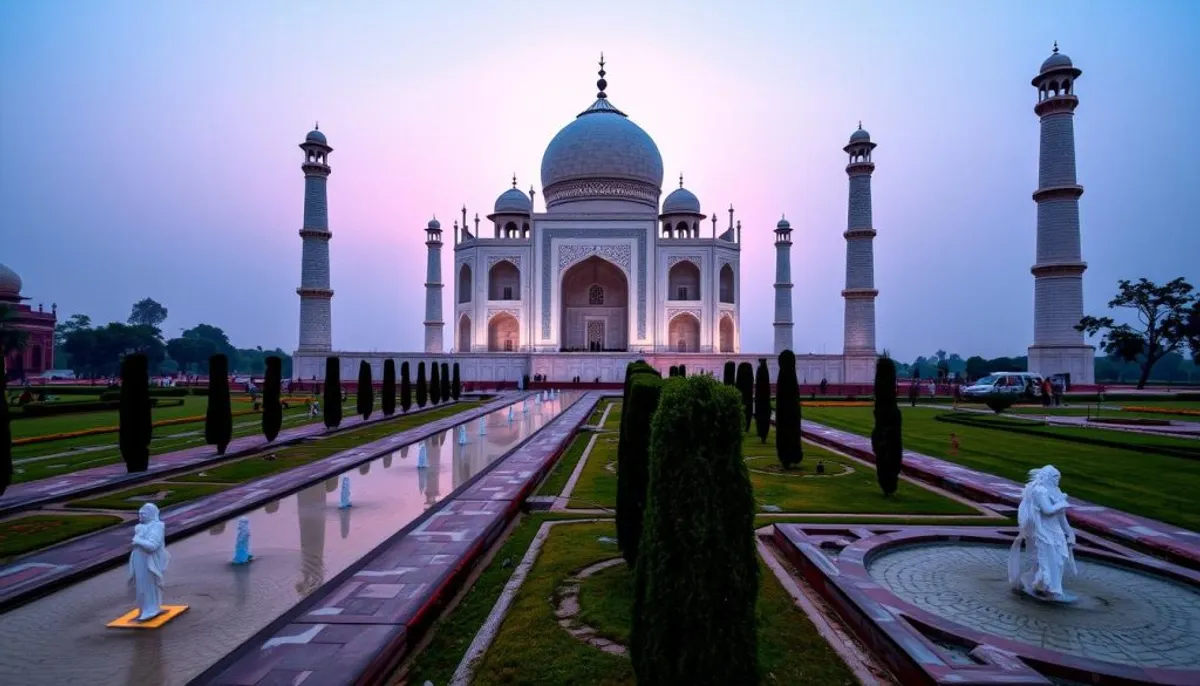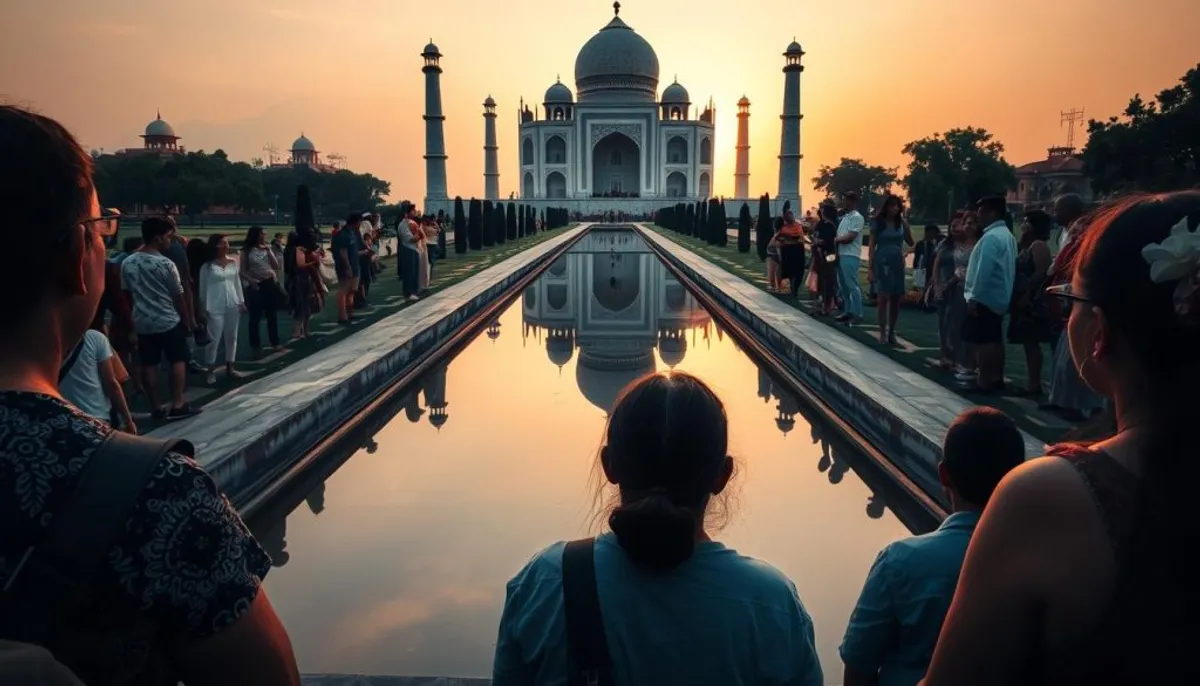The Taj Mahal is a UNESCO World Heritage site and one of the seven wonders of the world. It’s seen as the symbol of India. Shah Jahan, the Mughal emperor, built it in 1631 to honor his wife, Mumtaz Mahal, who had died that year.
Building the Taj Mahal started in 1631 and finished in 1643. It used materials from India, Central Asia, and the Middle East. This mausoleum shows the deep love Shah Jahan had for Mumtaz Mahal.
The Taj Mahal stands as the best example of Mughal architecture. It combines Persian, Islamic, and Indian styles. Its stunning marble dome, tall minarets, and detailed inlays have amazed people for years. It’s one of the most famous landmarks in the world.

Key Takeaways
- The Taj Mahal is a UNESCO World Heritage site and one of the new seven wonders of the world.
- It was commissioned in 1631 by the Mughal emperor Shah Jahan as a mausoleum for his beloved wife, Mumtaz Mahal.
- The Taj Mahal is a masterpiece of Mughal architecture, blending Persian, Islamic, and Indian design elements.
- The construction of the Taj Mahal began in 1631 and was completed in 1643, using materials from various regions of India, Central Asia, and the Middle East.
- The Taj Mahal’s iconic marble dome, towering minarets, and intricate inlays have captivated visitors for centuries.
Taj Mahal: A Heavenly Vision
The Taj Mahal changes its look with the day and light. At sunrise, it seems to float on mist, looking like a heavenly cloud. In the middle of the day, the heat makes the white marble look flat and stark.
But as evening comes or under moonlight, the Taj Mahal shines and sparkles. The optical illusions from its symmetry and Mughal architecture make it even more amazing. This Indian landmark is truly a wonder.
The Changing Faces of the Taj
Even those who know about the Taj Mahal are surprised by its beauty when they see it up close. Its huge scale and beauty are truly inspiring. It makes people appreciate the Mughal architecture more.
Exceeding Expectations
The Taj Mahal looks amazing in the soft dawn light, the hot midday sun, or under the moon’s glow. It always amazes and goes beyond what people expect, showing its timeless beauty.
The Tragic Love Story Behind the Taj
The Taj Mahal is a stunning monument. It shows the deep love between Shah Jahan, the Mughal emperor, and his wife, Mumtaz Mahal. Their story is filled with great sadness and deep love. This love story led to the creation of the Taj Mahal.
In 1631, Mumtaz Mahal died while with her husband on a military trip. Shah Jahan was deeply saddened by her death. He spent the next 22 years building the Taj Mahal. It was to be Mumtaz’s final resting place and a symbol of his love for her.
The Taj Mahal is seen as a masterpiece of Mughal architecture. It combines Persian, Islamic, and Indian styles. The Taj’s marble work, calligraphy, and symmetry show the Mughal Empire’s culture and art. They also show Shah Jahan’s deep love and respect for Mumtaz.
The story of the Taj Mahal touches people all over the world. It reminds us of love’s power, the depth of sorrow, and the lasting impact of love and grief.
Exploring the Taj Mahal Complex
The Taj Mahal complex is a true architectural wonder. It’s famous for its perfect symmetry and the amazing optical illusions it creates. When visitors come near the main entrance, the taj mahal looks huge and close. But as they move closer, it seems to get smaller – a trick of the eye that surprises everyone.
The Symmetry and Optical Illusions
The Taj Mahal complex is full of symmetry. The mosque and guest house are placed on either side of the main building, mirroring each other. This design looks beautiful and shows off the optical illusions that visitors love.
The Majestic Minarets
Around the Taj Mahal, there are four tall minarets, each 41 meters high. They add to the complex’s beauty. These thin, beautiful towers lean slightly outwards. They help the Taj Mahal look even more stunning and give visitors a great view of the mughal architecture.

The Taj Mahal complex is a masterpiece of symmetry, optical illusions, and minarets. It shows the amazing skill and vision of the Mughal architects who made this famous monument.
taj mahal
The Taj Mahal, in Agra, India, is a UNESCO World Heritage site. It’s one of the most famous monuments globally. Shah Jahan, the Mughal Emperor, built it to honor his wife, Mumtaz Mahal.
This monument still stuns people from all over. Its white marble shines brightly, with detailed patterns and calligraphy. The Taj Mahal’s perfect design shows the Mughal Empire’s skill and the hard work of its artists.
The Taj Mahal stands as a symbol of India’s culture and the Mughal Empire’s art. It’s a UNESCO World Heritage site, drawing millions of tourists yearly. They come to see its beauty and learn about its history.
For both first-time visitors and experienced travelers, the Taj Mahal is a must-see. Its beauty and lasting importance show India’s rich legacy. It proves that love can inspire amazing art.
Architectural Ingenuity
The Taj Mahal stands as a symbol of Mughal architectural brilliance. It shows off amazing engineering and design skills. At its core, the double dome design is a key feature. This design looks stunning and has a useful purpose too.
The Double Dome Design
The Taj Mahal’s double dome is a mix of a big onion dome and a smaller semi-dome. This design is a wonder of taj mahal architecture. It makes the monument look beautiful and also improves how it sounds.
The way the domes are placed lets a flute sound echo five times in the main room. This creates a magical experience for everyone who visits.
The Intricate Inlay Work
The Taj Mahal’s inlay work shows the amazing skills of Mughal artisans. The detailed patterns and designs, made with semi-precious stones, cover the walls and floors. They highlight the mughal architecture beautifully.
This level of detail and precision is what makes the taj mahal architecture so special. It draws in visitors from all over the world.
The Taj Mahal’s design, from its double dome to its intricate inlay work, shows the Mughal empire’s commitment to creating something timeless. It continues to amaze and inspire people everywhere.
The Mughal Gardens
The Taj Mahal complex is famous for more than just its stunning mausoleum. It’s also known for its beautiful Mughal-style gardens. These taj mahal gardens are a key part of the Taj Mahal’s design. They offer a peaceful place that shows the Mughals’ love for nature.
The mughal gardens around the Taj Mahal follow the charbagh design. This layout splits the area into four equal parts. It’s like the four rivers of paradise, showing the Taj Mahal’s connection to heaven.
A Representation of Paradise
The Mughal gardens near the Taj Mahal aim to bring a touch of heaven to earth. With greenery, flowers, and fountains, they create a calm and refreshing space. This takes visitors to a place of peace and thought.
- Beautiful flower beds and green lawns make the gardens look stunning next to the Taj Mahal.
- Paths and water channels through the gardens invite visitors to explore and see the Taj Mahal’s hidden spots.
- The gardens’ symmetry shows the Mughals’ love for order and balance in nature, just like the Taj Mahal’s design.
The Mughals blended the taj mahal gardens into the Taj Mahal’s design. This created a powerful and spiritual experience for everyone who visits this famous site.
Craftsmen and Materials
The Taj Mahal, a symbol of love in India, shows the amazing skill of Mughal artisans. They made this architectural wonder come to life. The work includes detailed stone carvings and fine inlay work.
Thousands of skilled workers and materials from the Mughal Empire and beyond helped build it. Calligraphers from Syria and Persia, stone carvers from Bukhara, and mosaicists from southern India were among them. They worked hard to make the beautiful patterns and designs on the monument.
The art of pietra dura, or intricate stone inlay, is a key feature of the Taj Mahal. This skill was mastered by these talented craftsmen.
To build the Taj Mahal, workers brought materials from far away. Over 1,000 elephants carried jasper from the Punjab, white marble from Makrana in Rajasthan, turquoise from Tibet, and lapis lazuli from various places. These materials were carefully chosen and combined by the Mughal artisans.
| Material | Origin |
|---|---|
| Jasper | Punjab |
| White Marble | Makrana, Rajasthan |
| Turquoise | Tibet |
| Lapis Lazuli | Various Sources |
The Taj Mahal’s creation shows the incredible skill and hard work of the Mughal artisans. They turned a dream of love into a lasting architectural wonder. This masterpiece still moves and inspires people all over the world.
Views from the Yamuna River
Looking at the Taj Mahal from the Yamuna River is a special experience. It’s how Shah Jahan saw it when he was in the Agra Fort. From here, you can see the Taj Mahal’s beauty from afar. It helps you understand why it’s so famous.
Walking around the Taj Mahal shows you different views. You can see it from the gardens and the areas around it. The Yamuna River reflects the Taj Mahal, making it look even more beautiful. This makes you feel like you’re in a magical place.
A Different Perspective
From the Yamuna River, the Taj Mahal looks amazing. Its size and beauty stand out even more. The Agra Fort makes a great background.
The way the light changes on the Taj Mahal is stunning. It makes you want to stay and enjoy its beauty. Seeing the Taj Mahal from the river is peaceful. It lets you see it in a new way that touches your heart.
| Viewpoint | Unique Highlights |
|---|---|
| Yamuna River |
|
| Taj Mahal Complex |
|
Through the Eyes of Visitors
The Taj Mahal often goes beyond what visitors expect. Its huge size and stunning beauty make a big impact on everyone. People often talk about the optical illusions they see there.
When visitors get close to the Taj Mahal, they’re often amazed. The monument looks smaller than they thought. This trick is thanks to its perfect symmetry and design. People also love the feeling of wonder and awe it gives them.
Walking around the Taj Mahal lets visitors see it from many angles. They can take photographs to remember their visit. These photos are not just keepsakes but also help people understand why the Taj is so special.
| Visitor Experiences | Highlights |
|---|---|
| Exceeding Expectations | Sheer scale and captivating beauty |
| Optical Illusions | Shrinking appearance, symmetry and design |
| Photography | Capturing different perspectives, cherishing memories |

The Taj Mahal amazes and delights people from all over the world. It leaves a mark with its grandeur, optical illusions, and the chance to take photos of its beauty.
Agra: Life Around the Taj
The Taj Mahal, India’s iconic symbol of love, has deeply influenced Agra and its surroundings. Tourism is now crucial to the local economy. The area’s narrow alleys and settlements are home to the descendants of artisans who built the Taj Mahal.
The Tourism Circuit
The tourism circuit around the Taj Mahal is a key part of visiting the area. It includes historic sites and cultural attractions. These give visitors a peek into the local culture and economy near this famous landmark.
Visitors can see Mughal architecture, explore local markets, and watch skilled artisans work. They create marble inlays and textiles similar to those used in the Taj Mahal.
| Top Attractions in the Agra Tourism Circuit | Key Highlights |
|---|---|
| Taj Mahal | India’s iconic monument of love, a UNESCO World Heritage Site |
| Agra Fort | A UNESCO World Heritage Site, showcasing Mughal architectural grandeur |
| Fatehpur Sikri | A well-preserved Mughal capital, another UNESCO World Heritage Site |
| Mehtab Bagh | A serene garden complex across the Yamuna River, offering stunning views of the Taj Mahal |
The vibrant life around the Taj Mahal enriches the visitor’s experience. It lets them dive into the rich cultural heritage and the thriving local economy. This has been shaped by the Taj Mahal’s presence.
Conclusion
The Taj Mahal is a lasting symbol of love, skill, and cultural heritage. It’s a UNESCO World Heritage site and one of the seven wonders of the world. People from all over the world visit this iconic monument in India.
Its beauty and the story of Emperor Shah Jahan’s love for his wife, Mumtaz Mahal, make it special. The area around the Taj Mahal is alive with tourism and a strong local community. This adds to the experience, showing off India’s rich culture.
Visitors can see the Taj Mahal’s beauty from the Yamuna River or through the eyes of those who’ve been there before. It’s a true wonder of human creation and a symbol of India’s cultural legacy. The Taj Mahal will keep inspiring and moving people for years to come.
RelatedRelated articles

